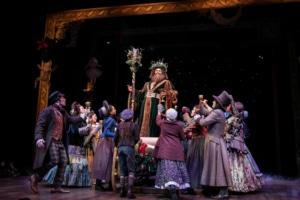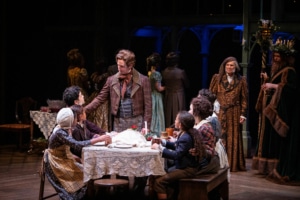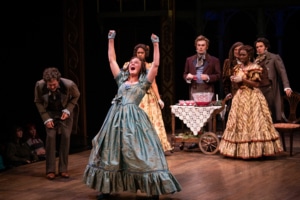DCPA NEWS CENTER
Enjoy the best stories and perspectives from the theatre world today.
Enjoy the best stories and perspectives from the theatre world today.
From the archives: this article was originally published on November 2, 2022
In England, caroling has always been an indispensable and joyous part of the Christmas holiday. Many of the earliest carols sung were preserved in a diary or “commonplace book” that was kept by Richard Hill, a grocer’s apprentice, between 1500 and 1536. Hill was interested in numerous subjects and carols were one of them. In 1850 his book was discovered wedged behind an old bookcase. Thanks to this piece of good fortune and Richard Hill’s curiosity, we have the earliest of all surviving English secular carols, “The Boar’s Head Carol.” The lyrics are:

“The boar’s head in hand bear I,
Bedecked with bays and rosemary;
And I pray you my masters merry be;
Quot estis in convivio. (Everyone who is at this feast.)
Caput apri defero, reddens laudes Domino (The boar’s head I bring, Giving praise to the Lord.)
British caroling was inextricably linked with wassailing. The word dates back to the 5th century and the Saxon toast “waes hal” meaning “Your health.” A common recipe for the drink includes brown ale, brown sugar, cinnamon sticks, nutmeg, ginger, lemon slices, roasted apples and one bottle of Madeira or sherry. As caroling groups went from house to house singing, they would receive cups of steaming hot wassail and food, in keeping with the custom that none who knocked on the door would be turned away.

The cast of A Christmas Carol. Photo by Jamie Kraus Photography.
By the Victorian age, caroling was a dying tradition. Oliver Cromwell and the Puritan regime (1649-1658) had banned Christmas carols and other observances of the holiday; the custom never returned in full vitality. In the 17th and 18th centuries, British printers tried to revive interest by circulating songs on cheap, oversized pieces of paper called “broadsides,” selling them for a penny. However, by 1830 caroling had degenerated into a sort of advanced begging technique employed by the poor.
By 1833 “God Rest Ye Merry Gentlemen” was known in the cities as the carol. William Sandys began in that year to compile his volume of Ancient and Modern Carols, but he had to travel to the midlands and farther north to collect any vestige of Christmas songs. However, the Victorians rediscovered the joy of these unique songs aided by Dickens’ story and a Victorian collection, Christmas Carols Old and New, published in 1871.

The cast of A Christmas Carol. Photo by Jamie Kraus Photography.
In the DCPA Theatre Company’s adaptation of A Christmas Carol by Richard Hellesen, several Victorian carols are included. “God Rest Ye Merry Gentlemen” is one, but others are less well known. “The Advent Carol” by Rowland H. Prichard is a lovely piece scored for string orchestras and bells. The “Londoners’ Carol” is also known as “Now Thrice Welcome Christmas,” but its composer and lyricist are unknown. It was first found in Poor Robin’s Almanac for 1695. In Edith Rickert’s Ancient English Christmas Carols: 1400-1700, it is known as “A Christmas Song.” Finally, Dickens himself wrote the lyrics to “The Hearty, the True and the Bold,” which is found in Chapter 28 of The Pickwick Papers.
These carols conjure up Dickens’ world of goodhearted fellowship, crackling fires and the spirit of goodwill.
The article was excerpted from Inside Out, the DCPA Theatre Company’s study guide.
DETAILS
A Christmas Carol
Noc 21-Dec 28, 2025 • Wolf Theatre
Tickets
